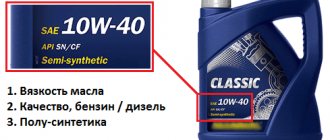The Lada Vesta sedan has been produced by the AvtoVAZ concern since November 24, 2015 and is equipped with four types of engines:
- VAZ-11189 – 1.6 l, 87 hp;
- VAZ-21129 – 1.6 l, 106 hp;
- VAZ-21176 – 1.8 l, 122 hp. ;
- HR16DE-H4M (Nissan) – 1.6 l, 114 hp.
The engine is the most important component of a car, so we will consider in more detail the choice of engine oil for it so that the engine life corresponds to that declared by the manufacturer, and the cost of lubricants is reasonable.
About the replacement process
Currently, Lada Vesta is equipped with two domestic gasoline 16-valve engines: 106-horsepower (model 21129) and 122-horsepower (model 21179).
Both engines are considered modern and high-speed, and this is one of the main parameters for selecting oil. And it is far from a fact that what kind of oil was poured into the Lada Vesta engine from the factory is what should be poured in the future. This article will try to provide arguments in favor of and against this statement. The first engine oil change should be done after 1.5-2 thousand kilometers. The lubricating fluid filled in at the factory is designed only for the engine break-in period. The second and subsequent replacements proposed by AvtoVAZ should be carried out every 15,000 kilometers.
Changing the oil in a Lada Vesta engine should ideally be done by professionals in a car service center. But this procedure can also be performed by an ordinary car enthusiast. Follow the step-by-step instructions and you will succeed:
- Open the hood and unscrew the filler cap;
- Unscrew the drain plug on the engine crankcase;
Change of oil - Drain the contents into a previously prepared container;
- We dismantle the old oil filter to replace it with a new one;
According to the manufacturer, the oil volume in the Vesta engine is 4.4 liters (with a manual gearbox) and 3.2 liters (with a robotic transmission).
Under normal operating conditions and in the absence of force majeure situations, changing the oil in a Lada Vesta car is the most frequent and very important part of maintenance.
The first oil change for the Vesta manual transmission, according to AVTOVAZ recommendations, should be done after 75,000 km or five years of operation (whichever comes first).
The correct choice of oil and accurate execution of the operation itself is the key to ensuring that the car will serve you for a long time and will not bring unpleasant surprises. We hope that this article did not leave any open questions, and therefore turned out to be useful.
Engine oil quantity
The car is available with three types of power units. Depending on the installed transmission and crankcase, the volume of oil in the Lada Vesta engine is different.
ICE model VAZ 21129
The engine has a volume of 1.6 liters and produces 106 l/s. Together with the power unit, depending on the model, a manual or robotic gearbox is installed. The AMT version has a stamped oil sump, while the manual transmission has a cast oil sump.
At the factory, models with AMT are filled with 3.2 liters of engine oil; when changing the lubricant and filter, 2.9 is used. In the version with manual transmission, the first filling is 4.4 liters, when replaced - 4.1.
When replacing, it is recommended to wait until the lubricant is completely drained or clean the pan with a vacuum suction. The large volume of used oil remaining in the engine impairs the performance of the power unit and reduces its service life.
HR16DE
The engine developed by the Renault-Nissan concern is produced at AvtoVAZ with the factory designation H4M. Volume – 1.6 liters, power – 113 l/s. Since 2021, the power unit will be equipped with a CVT. The volume of lubricant is the same as that of motor 21129.
ICE VAZ 21179
The volume of the power unit is 1.8 liters with a power of 122 l/s. Install manual transmission or AMT. A cast crankcase is used for a manual transmission, while a stamped crankcase is used for a variator. Just like with a 1.6 liter engine, an automatic transmission will require 3.2 liters during the first factory fill, and 2.9 liters during a subsequent change of lubricant.
A manual engine with a cast oil sump requires filling 4.15 liters, and when changing - 3.85 liters of lubricant.
Basic information
Today, the Lada Vesta is equipped with two Russian gasoline engines with 16 valves:
- 106 horsepower engine, model 21129
- 122 horsepower engine, model 21179
These devices are modern, have a large number of revolutions, and this is the most important point when choosing oil for a machine.
Many people wonder what kind of oil is poured into the Lada Vesta engine from the factory; it is believed that it is the best, but this rule does not work in all situations.
If one oil was filled, then it can be changed to another.
Types of motor oils
Among engine oils, there are the following types that are used most often:
- Mineral based
- Made from semi-synthetic materials
- Fully synthetic
They differ only in origin.
The first are created from oil, the second are a transition link between artificially created oils and natural ones, with a certain set of additives, the third are formed by combining additives with plasticizers, their goal is to reduce friction regardless of temperature.
Synthetic-based lubricants are quite viscous; mineral oils cannot offer the same capability.
It is better to fill the engine with non-mineral oil, since it is not stable in its chemical composition, which means it will work less.
Another advantage of synthetics is its isothermal properties; such oil will work in a temperature range of -40 to 50.
Mineral oil at the same indicators will either freeze or become very liquid.
A world of friction-reducing
The most popular groups of oils used for passenger car engines are:
- Mineral;
- Semi-synthetic;
- Synthetic.
The difference between them is their origin. The former are obtained directly from oil. The latter are an intermediate link between artificially obtained and natural ones, improved by a set of additives. The third is the result of a complex synthesis of additives and plasticizers, with the goal of reducing friction at any temperature.
Synthetic lubricants have a viscosity that mineral lubricants cannot offer to an engine. In addition, it is better to fill an engine with 16 valves with “non-mineral water”, since it is more stable in chemical composition, which allows you to increase the period between replacements. Its high isothermal properties also speak in favor of synthetics.
Oil options for Lada Vesta
The manufacturer of this brand of car categorically recommends filling the car with synthetic oil SAE5W-30 or SAE5W-40. The meaning of these letters will be discussed below.
SAE is an acronym that stands for Society of Automotive Engineers.
The value from 0W to 30W is used for winter, there are 6 oils in total in increments of 5W.
For other seasons, there are 5 more engine oils, from 20 to 60, in increments of 10.
The creator company itself was created in 1911, its oil standards developed were accepted by the whole world, which are still the standard to this day.
Now examples will be given of which engine oil is best for Lada Vesta.
SAE 5W30 and SAE5W40 - this is the oil that is poured into this brand of car at the factory; due to its ductility and viscosity, it will remain in its normal state from 35 to -35, such indicators completely coincide with the climate of Europe and Russia.
The plant in Volzhsk advises filling cars with oil from Russian companies, from Lukoil and Rosneft.
Only two of these companies have the privilege of being the manufacturer of the machines, which means that the lubricant is perfectly compatible with other parts of the machine.
You can also fill the engine with foreign oils with category 5W30:
- Mobil, you can still use 5W40, 0W40 - only for new cars
- Motul Specific DEXO S2
- Shell HELIX HX8
Engine oil change and main “sores”
The car is equipped with a 122-horsepower 16-valve injection engine VAZ 21176 with a displacement of 1.8 liters. Its common and traditional “sore” is increased oil consumption, or oil burn, which, according to experts, is a consequence of the use of low-quality Chinese-made valves.
Another problem is that acceleration to 100 km/h is slow for such a powerful engine - only 12 seconds - apparently this is due to the characteristics of the transmission, which is not sufficiently adapted to the characteristics of the engine. But there's nothing you can do about it. Otherwise, the car did not cause any complaints until, over time, the engine began to have difficulty starting in cold weather, began to tune up, operated intermittently at low speeds, and even stalled in idle mode. Recently, beating of hydraulic compensators has also been observed, as evidenced by characteristic noise in the cylinder head.
Everything became clear after opening the valve cover: its inner surface and parts of the valve mechanism were covered with a thick resinous layer of carbon deposits.
As, indeed, are the spark plug skirts. There was no doubt that when dismantling the cylinder head, similar manifestations would certainly be found on the pistons. Needless to say, the injector nozzles were also clogged?
I don’t want to shake my fists at the designers. Undoubtedly, the root cause of all the troubles was the low quality of domestic gasoline and the non-compliance with the required specifications of the used motor oil, the replacement of which, in addition, was not always carried out in compliance with the regulations due to constant busyness at work.
Having finally chosen the time, I decided not to take the car to a car repair shop, to begin with, preferring “outpatient procedures” in my own garage. And the procedures were simple: flushing the engine and changing the oil with the accompanying introduction of “medicinal” additives.
A set of additives with oil for complete maintenance
Using the Liqui Molу Oilsystem Spulung Effektiv oil system flushing/cleaner art. 7591, poured liquid into the engine and let it idle for about half an hour, after which he drained the used oil with carbon deposits dissolved in it.
Then a new oil was poured into the crankcase - all-season hydrocracking (HC) synthetic Liqui Moly Optimal New Generation with a package of anti-friction detergent additives based on molygen - a combination of microparticles of molybdenum and tungsten, which strengthens the working surfaces of friction pairs by creating a very strong film on them. The product has the required approvals - ACEA A3/B4 and API SN.
The anti-friction characteristics were further enhanced thanks to the introduction of the Liqui Molу Cera Tec additive, which gives the resulting protective coating the properties of ceramics with a graphite-like laminar structure based on hexagonal boron nitride, which significantly reduces the coefficient of friction and increases wear resistance. The introduced additives, by imparting additional antifriction properties to the friction surfaces, significantly extend the service life without polluting the oil filter.
How to choose engine oil for Lada Vesta
Instead of wasting time on useless debates about which oil is better - Russian or foreign, you should pay attention to the fact that all oils are of high quality, and you just need to buy only real ones, and not counterfeit ones. We will leave the choice of oil to the opinion of the drivers.
When asked what kind of oil to fill in the Lada Vesta, the manufacturer gives a clear answer - synthetic grades SAE5W-30 or SAE5W-40. Let's shed some light on what these numbers and letters mean:
- SAE (Society of Automotive Engineers) is an abbreviation for the Society of Automotive Engineers;
Below are clearly presented recommendations on which oil to pour depending on the temperature of their operation.
Oil selection
- SAE 5W30 and SAE5W40 - this is the oil that is poured at the factory as the optimal engine oil for Lada Vesta. Their properties, such as viscosity and fluidity in the temperature range from -35 to 35, are excellent for almost all climatic zones of Russia and Europe, where the export of cars with a rook on the radiator grill is growing dynamically.
- Mobil (5w40 is also allowed, and for new cars 0w40);
- Motul Specific DEXO s2;
- Shell HELIX HX8.
It is these two concerns that have AvtoVAZ approvals, and this is the highest degree of trust and guarantee of compatibility of the lubricant and all engine parts.
Among foreign manufacturers, oils with the characteristic 5w30 are recommended:
Oils for Lada Vesta
In order not to waste time on polemics about which engine oil is better for Lada Vesta - imported or domestic, we will give the right of choice to the car owners themselves. Note that the quality of the original lubricants is almost the same, but what to pour into the engine - real or counterfeit - is a concern, first of all, for the buyers themselves.
Technologically, when operating engines 21127 and 21177, it is determined how much oil should be lost when the engine is running. This figure for Vesta is about 100 g per thousand kilometers. Therefore, periodic monitoring of oil availability is mandatory for owners of Lada Vesta. The optimal level will be between o and “min” on the meter probe.
Car owners should remember that a lack of lubricant is just as harmful as its excess. So, excess oil on the Lada Vesta, or more precisely, its vapors, can enter the combustion chamber through the breather. This will cause enrichment of the exhaust gases and, as a result, disable the entire Euro 5 environmental system.
There are three main and most popular groups of oils for technical equipment:
- mineral based;
- on a semi-synthetic basis;
- on a synthetic basis.
The main difference between the groups is the material and components for manufacturing. Mineral - made from petroleum. Semi-synthetic - partly from petroleum, partly from a synthetic base. Synthetic oil is made by 99.0% artificial synthesis with the addition of plasticizers.
Synthetic oils “offer” a high viscosity coefficient, which “mineral oil” cannot provide. And this is the main advantage of synthetics over petroleum base.
It is not recommended to use mineral-based engine oil in Lada Vesta. Semi-synthetics can be used in exceptional cases. The main emphasis is on synthetics, which have a wide temperature range from -40 to 55°C, high fluidity and viscosity.
Foreign manufacturers always focus on “their” car market. The domestic manufacturer relies on the technical characteristics of Russian cars, respectively.
At the same time, foreign analogues are compatible with engines of domestic cars. The reverse process is not always possible, at least at this stage of development of Russian technologies.
In recent years, cases of mass counterfeiting of motor oils, including foreign ones, have become more frequent. The reason for this phenomenon is obvious - the possibility of making more profit.
Domestic brands are also counterfeited, but to a lesser extent. Therefore, service station managers recommend always buying consumables and oils at official points of sale.
The oil has become unsuitable for the car: how to find out and what to do?
To find out if the dipstick is useful, you need to drop a drop of it onto paper and wait until it dries, about 15-20 minutes.
Using a drop, you can determine whether the oil was working or not, whether it contains mechanical impurities, or whether the liquid came from an engine that overheated.
The determining factor will be the color; if it is dark, it means there are few substances useful for the car, and the opposite situation, when the color is light, is also bad.
Engine lubricants should be viscous, this will ensure long-term operation and parts will wear less.
The properties of liquids also differ significantly.
- Synthetic – used for new cars with low mileage and can withstand temperature changes well
- Half synthetic – mainly used for worn out engines
- Mineral - low quality and price, unsuitable for high and low temperatures
The best semi-synthetic oils for Lada Vesta
Synthetic oil can provide maximum protection for all engine components. It retains all its best characteristics both in hot weather and in severe frost. Experts recommend pouring the following products into the Lada Vesta engine.
Castrol Edge 5W-30
The Castrol Edge 5W-30 synthetic oil stands out from its competitors with the most durable film. The German manufacturer managed to achieve this effect thanks to the successful implementation of Titanium FST technology. Reliable protection of engine parts is ensured even under high loads. Experts note the wear resistance of the product, so the most important properties of the oil are maintained throughout the entire service life.
Motorists note an improvement in acceleration dynamics, some even found savings in gasoline. Only the sound of the running engine becomes different.
After the warranty period expires, you can switch to semi-synthetic oil. It has proven itself well in European winter conditions, when the air temperature in winter rarely drops below -20°C. Experts have selected several suitable motor oils.
SHELL Helix HX7 10W-40 semi-synthetic product deserved the most flattering words from experts. It combines affordability with a long service life. If most competitors manage to make semi-synthetic oil with a service life of 5 thousand km, then SHELL Helix HX7 can be changed after 7 thousand km. The advantages of the lubricant include maintaining fluidity at low temperatures.
Semi-synthetics win our rating for durability, versatility of use and reasonable price. You should only buy it from trusted suppliers due to the presence of counterfeit products on the market.
In warm regions of the country, mineral oil can be used successfully. It is also suitable for use in the spring-autumn season, if during this time the car runs up to 5 thousand km. Here are the best mineral waters for use in Lada Vesta today.
SHELL Rimula R4 X 15W-40 engine oil was developed for use in loaded power units. Therefore, the manufacturer paid special attention to maintaining performance throughout the entire service life. Experts note excellent neutralizing ability, due to which parts are well protected from corrosion.
Car owners are satisfied with the combination of price and quality, wear resistance and durability. So far there have been no complaints about the oil from users.
Classification of motor oils by base
Based on the type of base, lubricating fluids are usually divided into:
- synthetic;
- semi-synthetic;
- mineral.
This classification is conditional - fully synthesized oils are not produced, the manufacturing technology for all 3 types is the same - mineral-based, but “synthetic” and “semi-synthetic” oils differ from mineral oils in their high content of quality additives that improve the fluidity and performance of lubricating compounds, but increase their cost.
All Lada Vesta engines are modern power units, so for their operation it is optimal to use synthetic and semi-synthetic oils, which are more fluid and quickly distribute throughout the internal combustion engine lubrication system and clearances.
In regions with winter temperatures below -30 degrees, the use of mineral oils is strictly not recommended due to the possibility of their thickening and even complete freezing.
How to change oil?
Now we will talk about how to change it to a Lada Vesta.
The very first oil change in the engine should be carried out after driving 1.5-2 thousand kilometers, since the lubricant liquid poured at the factory is intended only for running-in the engine.
It is better to carry out the oil change process in a specialized car service center, but if there is no opportunity or desire, then you can do everything yourself, the main thing is to follow the instructions written below, but before you start, read the following. The oil filter in the Lada Vesta is located in an inconvenient place, so to remove it you need a special key, and before installing a new filter, lubricate the sealing ring with oil, old or new.
Here's how to change the oil in your car:
- You need to open the hood and unscrew the filler cap
- Unscrew the drain plug on the engine
- Drain the old oil into a prepared container
- We remove the unusable oil filter and replace it with a new one.
- Now you need to wait until the old oil has completely drained, then screw the crankcase plug back in. To successfully drain and add oil, you can use a wide watering can, thanks to it nothing will leak and the engine will remain clean
- Now fill in synthetic oil, after a few minutes check the level with a dipstick; if the oil is not enough, then add more. You should not pour two oils into one engine, since any oil has a complex chemical composition, and mixing it with an oil designed differently can lead to problems during operation.
- We screw the filler cap back, close the trunk, and start the car. If you did all the work correctly, the oil level control on the dashboard of the car will go out. You can go by car right now
This replacement option was carried out without cleaning the engines from the remnants of the previous oil. If you want to clean the car of the previous fluid, here are some more tips:
- You can buy the additive and drive by car, the route indicated on the package
- Another option involves using flushing fluid; after filling it in, you need to let the machine run for a while, but it is better not to use this method. When you wash, find out how long you need to do it, if it’s 20 minutes, then it’s better to wash for 5-7 minutes less, these are the tips of experienced drivers. After all, if you wash it for a long time, the old dirt may fall off and ruin the car’s engine.
What kind of oil to pour into the Lada Vesta engine. Expert advice on choosing
Manufacturer's recommendations. All cars that leave the AvtoVAZ checkpoint are filled with technical fluids. The manufacturer uses synthetic oils SAE5W-30 or SAE5W-40 from well-known Russian oil companies Lukoil and Rosneft on the conveyor. These products are also recommended for dealerships that service vehicles under warranty.
Lubricants are all-season, they can successfully protect engine components at both high (30..35°C) and low (-30..-35°C) temperatures. The interval between replacements is 15 thousand km, but experts advise the first replacement after running-in to be carried out after 1.5-2.0 thousand km.
Mileage factor. Lada Vesta cars are still young (production began in 2015), so many owners visit service centers for warranty maintenance. But after the warranty expires, many motorists will switch to changing the oil themselves. Then you will have to take into account the mileage factor.
When the car's mileage is within 150-200 thousand km, it is best to use all-season oil designated 5W30, 5W40 or 10W30. Synthetic products meet these requirements.
When the engine has worked out more than a quarter of its service life, it is allowed to use mineral or semi-synthetic oil 15W40 or 10W40 in the summer. If the winter in the region is harsh, then there is no alternative to synthetics.
Features of operation. The engine oil change interval depends on the operating conditions of the vehicle. Car enthusiasts with a relaxed driving style who live in small towns can change the oil after 15 thousand km. But residents of megacities spend a lot of time in city traffic jams. If a motorist likes dynamic driving, then the service life of the lubricant is limited to 10 thousand km. These indicators apply only to synthetics.
We have selected 9 best oils for Lada Vesta for review. All lubricants can be purchased at auto stores across the country. When compiling the rating, the opinion of the expert community and reviews of car enthusiasts were taken into account.
The class of motor oil directly affects the service life of the equipment. The discrepancy between the viscosity coefficient and the quantitative composition of chemical additives increases the temperature regime and increases the friction force on the surface of parts. Ultimately, the powertrain mechanisms wear out prematurely.
For each vehicle, the manufacturer has developed individual lubrication standards. The exact data is indicated in the operating instructions. Strict adherence to the recommendations will ensure a long service life of the machine components.
Before purchasing, please carefully read the specifications in the instruction manual. If you have any difficulties with the choice, consult with service station specialists.
Buy consumables and oils at official points of sale. Require sellers to provide quality certificates for their products.
Carefully check the presence of the barcode, date and batch number, integrity of the packaging, and canisters. If there is damage or visible defects, refuse to purchase.
Domestic or foreign oils - the choice is up to the car owner. Here take into account the cost and the size of the maintenance budget. We recommend giving preference to foreign products; domestic lubricants are an economical option. Recommended oil by the manufacturer: 5W30, 5W40 Lukoil, Rosneft, as well as foreign analogues.
Manufacturer's recommendations
AvtoVAZ recommends that consumers use Russian and Rosneft oils in Lada Vesta engines, and when servicing these cars, dealerships use products from these very companies labeled 5W40.
The operating instructions for VAZ engines say that the oil should be changed after 15 thousand kilometers, but better - after 7.5 thousand kilometers. If we mean the products of the above-mentioned manufacturers, then this recommendation raises some doubts, since the fuel and lubricants market contains products from many foreign enterprises that have proven themselves well in Russia and have been confidently used by the world's leading automakers for decades.
For those who are willing to pay not only for quality, but also for belonging to the brand, we will consider the possibility of using these products in Lada Vesta engines, having familiarized ourselves with the types of motor oils, classifications and recommendations of specialists.
Additional useful information
Based on the data provided by the manufacturer, the amount of oil held for a car with a manual transmission is 4.4 liters, and if the transmission is automatic, then the number is less, 3.2 liters.
If normal operating conditions of the machine are observed and there are no unexpected circumstances, then changing the oil in the machine will be the most frequent process and at the same time a very responsible one.
Changing the manual transmission oil in the Lada Vesta, following the instructions of AVTOVAZ, should occur every 75 thousand kilometers or after 5 years of using the car, this date will come faster than such a high mileage.
It is better to choose engine fluid with a specialist; this could be a store or a simple gas station.
How much to fill
Nominal filling volumes are indicated in the Lada Vesta operating manual:
| Unit | Volume, l |
| Engine lubrication system: – 21129 (cast oil sump) – 21129 (stamped oil sump) – 21179 (cast oil sump) – H4M | 4,4 (4,1)* 3,2 (2,9)* 4,4 (4,1)* 5 (4,2)* |
| Engine cooling and interior heating system** – 21179/21129 – H4M | 7,0 (6,4) 7,0 (6,3) |
| Transmission: – AMT 2182 – MT 2180 – MT JR5 515 – Continuously variable automatic (CVT) | 2.25±0.05*** 2.25±0.05*** 2.2*** 6.9 (full volume) |
| Hydraulic clutch and brake system | 0,559 |
| Hydraulic brake system (for versions with AMT) | 0,517 |
| Ozone-safe freon R1234yF in the air conditioning system, kg**** | 0,475±0,02 |
| Ozone-safe freon R134a in the air conditioning system, kg | 0,475±0,02 |
* When changing the oil (without replacing the oil filter). ** The use of mixtures of coolants of different brands is not allowed. *** Reference value! The oil level should be at the lower edge of the filler hole. **** Variant execution.
It is noteworthy that the consumption standards for technical fluids and the technological instructions indicate the amount of refrigerant charged to the LADA Vesta climate system (410 and 390+/-20) grams, respectively.










